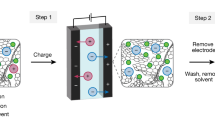Abstract
MOLYBDENUM disulphide, MoS2, undergoes oxidation in bulk at temperatures above 450° C, which may be demonstrated1 by gravimetry. However, the substance must ordinarily be covered with a surface layer of oxide, since heating samples in a good vacuum leads to the evaporation of molybdenum trioxide. It is possible that such layers are involved in the frictional transients observed2 when molybdenum disulphide is used as a lubricant in wet atmospheric environments. It is germane to inquire as to the origin of the oxide layers, and we wish to comment on the possible extent of the hydrolytic decomposition of molybdenum disulphide to yield hydrogen sulphide and molybdenum dioxide. Haltner found2 that when an MoS2 film, supported on certain metals, and particularly copper, was exposed to rubbing and shearing forces in a wet atmosphere, hydrogen sulphide could be detected. If no metal is present, however, the reaction appears to be different, for Cannon3 found that the gravimetry of adsorption of water on fine particle molybdenum disulphide showed a strong and extensive irreversible interaction at 0° C. The latter also found that for very finely dispersed samples, if the specific surface area, rather than the mass of the solid, were taken as the extensive variable, the observed gravimetry conformed most closely with the reaction :  rather than a hydrolysis. While no search for hydrogen evolution was made in the earlier experiments1–3, an examination of the thermal behaviour3 of the putative oxysulphide indicated that a temperature of 350° C could be attained before any appreciable loss in weight was observed, and that this loss appeared to be associated with the formation of sulphur dioxide rather than hydrogen sulphide. It thus seemed likely that the reaction of molybdenum disulphide with water, studied in the absence of metals under conventional high vacuum conditions, was not a hydrolytic process of sulphide to oxide plus hydrogen sulphide, but a net oxidation. We have now extended the work to higher temperatures, with the following interesting results. The water adsorption work was repeated at 180° C, 20µ water vapour pressure, in quartz microbalance equipment like that described before1,3. The surface-area limited reaction with a permanent weight increase proportional to the specific surface area was seen again. 20 g samples of molybdenum disulphide (Σ = 15 m2/g) were then exposed to 20 mm water vapour at progressively higher temperatures between 200° and 500° C. The experiments were conducted in a quartz envelope to permit pre-degassing the solid. Pressures were monitored through the seven-day holding period of each of the experiments and gas samples were withdrawn for mass spectrometric study after one day each at various temperatures. The results are summarized in Table 1.
rather than a hydrolysis. While no search for hydrogen evolution was made in the earlier experiments1–3, an examination of the thermal behaviour3 of the putative oxysulphide indicated that a temperature of 350° C could be attained before any appreciable loss in weight was observed, and that this loss appeared to be associated with the formation of sulphur dioxide rather than hydrogen sulphide. It thus seemed likely that the reaction of molybdenum disulphide with water, studied in the absence of metals under conventional high vacuum conditions, was not a hydrolytic process of sulphide to oxide plus hydrogen sulphide, but a net oxidation. We have now extended the work to higher temperatures, with the following interesting results. The water adsorption work was repeated at 180° C, 20µ water vapour pressure, in quartz microbalance equipment like that described before1,3. The surface-area limited reaction with a permanent weight increase proportional to the specific surface area was seen again. 20 g samples of molybdenum disulphide (Σ = 15 m2/g) were then exposed to 20 mm water vapour at progressively higher temperatures between 200° and 500° C. The experiments were conducted in a quartz envelope to permit pre-degassing the solid. Pressures were monitored through the seven-day holding period of each of the experiments and gas samples were withdrawn for mass spectrometric study after one day each at various temperatures. The results are summarized in Table 1.
This is a preview of subscription content, access via your institution
Access options
Subscribe to this journal
Receive 51 print issues and online access
$199.00 per year
only $3.90 per issue
Buy this article
- Purchase on Springer Link
- Instant access to full article PDF
Prices may be subject to local taxes which are calculated during checkout
Similar content being viewed by others
References
Cannon, P., Nature, 183, 1612 (1959).
Haltner, A. J., and Oliver, C. S., paper 13, Div. Petroleum Chem., 134th meeting, American Chemical Society, Chicago, Illinois (Sept. 1958); see also Gen. Elec. Res. Lab. Rep. 63–RL–3495C
Cannon, P., J. Chim. Phys., 58, 130 (1961).
Author information
Authors and Affiliations
Rights and permissions
About this article
Cite this article
CANNON, P., NORTON, F. Reaction between Molybdenum Disulphide and Water. Nature 203, 750–751 (1964). https://doi.org/10.1038/203750a0
Published:
Issue Date:
DOI: https://doi.org/10.1038/203750a0
This article is cited by
-
Hygroscopicity Analysis and Tribo-mechanical Characterizations of Conditioned PA6/MoS2/h-BN Hybrid Composite
Journal of Inorganic and Organometallic Polymers and Materials (2023)
-
One-pot growth of two-dimensional lateral heterostructures via sequential edge-epitaxy
Nature (2018)
-
The Effects of Environmental Water and Oxygen on the Temperature-Dependent Friction of Sputtered Molybdenum Disulfide
Tribology Letters (2013)
-
Reactions of molybdenum disulfide with some gases and water vapor
Soviet Powder Metallurgy and Metal Ceramics (1983)
Comments
By submitting a comment you agree to abide by our Terms and Community Guidelines. If you find something abusive or that does not comply with our terms or guidelines please flag it as inappropriate.



